IASbaba's Daily Current Affairs Analysis
Archives
(PRELIMS & MAINS Focus)
Syllabus
- Prelims – Economy
Context: According to analysis by Global Energy Monitor (GEM), a firm that tracks utilisation of the fuel-source internationally – on average India’s coal mines use only two thirds of the capacity with some large ones using only 1 percent.
About Coal in India:
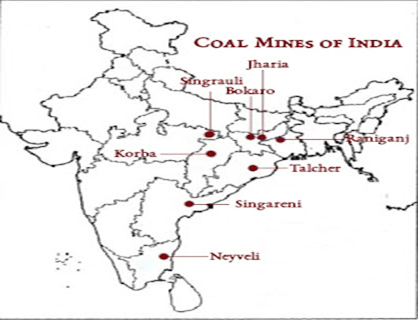
- India is the second largest producer and consumer of coal after China.
- Jharkhand is the largest coal-producing state in India.
- The top coal-producing states includes Odisha, Chhattisgarh, West Bengal, Madhya Pradesh, Telangana and Maharashtra.
- Coal accounts for approximately 55% of the country’s energy needs compared to other energy sources.
Types of Coal:
Anthracite:
- Anthracite is the best quality of coal which carries 80 to 95 per cent carbon content.
- It ignites slowly with a blue flame and has the highest calorific value.
- It is found in small quantity in Jammu and Kashmir.
Bituminous:
- Bituminous carries 60 to 80 per cent of carbon content and a low level of moisture content.
- It is widely used and has high calorific value.
- It is found in Jharkhand, West Bengal, Odisha, Chhattisgarh and Madhya Pradesh.
Lignite:
- Lignite is often brown in colour. It carries 40 to 55 per cent carbon content.
- It is an intermediate stage which happens during the alteration of woody matter into coal.
- It has high moisture content, so it gives smoke when burnt.
- It is found in Rajasthan, Lakhimpur (Assam), and Tamil Nadu.
Peat:
- Peat has less than 40 per cent carbon content.
- It is in the first stage of transformation from wood to coal.
- It has low calorific value and burns like wood.
About Global Energy Monitor:
- In 2007, responding to a call to action by climate scientist James Hansen, an informal group of journalists and environmental advocates began documenting 151 proposed coal plants in the United States which eventually became Global Energy Monitor.
- Global Energy Monitor was founded on principles of transparency and accountability.
- In 2014, GEM released the Global Coal Plant Tracker, an interactive database cataloguing thousands of coal-fired plants in all stages of development.
- GEM’s team consists of researchers from around the world whose work enhances public understanding of the global energy system.
- Global Energy Monitor is a mission-driven Non-Profit organization. A majority of funding comes in the form of charitable donations from foundations and individuals.
Source: The Hindu
Previous Year Question
Q.1) With reference to India, consider the following statements:
- Monazite is a source of rare earths.
- Monazite contains thorium.
- Monazite occurs naturally in the entire Indian coastal sands in India.
- In India, Government bodies only can process or export monazite.
Which of the statements given above are correct? (2022)
- 1, 2 and 3 only
- 1, 2 and 4 only
- 3 and 4 only
- 1, 2, 3 and 4
Q.2) Consider the following statements:
- Coal ash contains arsenic, lead and mercury.
- Coal-fired power plants release sulphur dioxide and oxides of nitrogen into the environment.
- High ash content is observed in Indian coal.
Which of the statements given above is/are correct? (2020)
- 1 only
- 2 and 3 only
- 3 only
- 1, 2 and 3
Syllabus
- Prelims – International Relations
Context: Indians, who represent the second largest cohort of international students in some of the world’s most developed economies, are strongly overrepresented in STEM (science, technology, engineering and mathematics) subjects, particularly in engineering, according to The International Migration Outlook Report 2022.
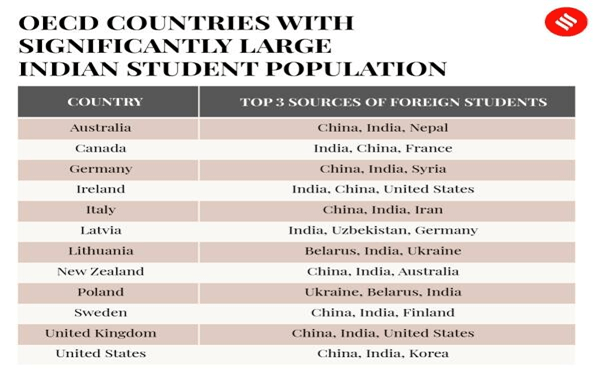
Findings of the report:
- The 2022 edition of International Migration Outlook analyses recent developments in migration movements and the labour market inclusion of immigrants in OECD countries. It also monitors recent policy changes in migration governance and integration in OECD countries.
- During 2017/18, nearly half of the international students in the USA were studying STEM subjects, and this share was around 79 per cent for Indian students, substantially more than the Chinese (45 per cent).
- Germany reported three large groups of international students primarily enrolled in engineering fields in 2021 out of which Indian students constituted a total of 66 per cent surpassing Chinese students who accounted for a total of 50 per cent.
- In 2016-17, more than half of the Indian students in the Netherlands were admitted to engineering degree programs.
- Factors that Indian students take into consideration before moving abroad for higher education.
- lower fees and a prospective job market.
- geographical proximity,
- the language of instruction,
- policies regarding access to the labor market even during the course of study.
- Therefore, countries like Australia, Norway, Germany, and Switzerland see an influx of Indian students.
Source: Indian Express
Syllabus
- Prelims – Science and Technology
In news: According to the study published in the journal Astronomy and Astrophysics, scientists have detected barium in the upper atmosphere of two giant exoplanets for the first time.
- European Southern Observatory’s Very Large Telescope located in the Atacama Desert, northern Chile was used in the process.
About:
- The scientists confirmed the presence of hydrogen, lithium, sodium, magnesium, calcium, vanadium, chromium, manganese, nickel and iron, in addition to barium.
- Additionally, the team found elements such as cobalt, strontium and titanium
- Discovery of barium is surprising because heavy elements like barium are expected to quickly fall into the lower layers of the atmosphere, given these exoplanets have high gravity.
- Barium, two and half times heavier than iron, is the heaviest-ever detected element.
About the Exoplanets:
- These exoplanets are two ultra-hot Jupiters — WASP-76b and WASP-121b — which orbit their host stars WASP 76 and WASP 121.
- The former is about 640 light-years away from the Earth and the latter around 900 light-years away.
- Ultra-hot Jupiters are a class of hot gaseous planets that matches the size of Jupiter. But they have short orbital periods, unlike Jupiter.
- Both WASP-76b and WASP-121b complete one orbit in two days.
- Surface temperatures in these bodies reach as high as 1,000 degrees Celsius.
- These bodies have unique features owing to their high temperatures. For instance, WASP-76b experiences iron rain.
About Barium:
- Barium is a chemical element with the symbol Ba and atomic number 56.
- The element is used in metallurgy, and its compounds are used in pyrotechnics, petroleum production, and radiology.
- Soluble barium compounds are poisonous. In low doses, barium ions act as a muscle stimulant, and higher doses affect the nervous system, causing cardiac irregularities, tremors, weakness, anxiety, shortness of breath, and paralysis.
- Because of its high chemical reactivity, barium is never found in nature as a free element.
- Barium salts are used in fireworks to generate green lights.
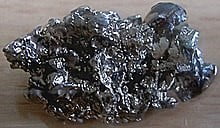
Source: Down to Earth
Previous Year Question
Q.1) Which one of the following sets of elements was primarily responsible for the origin of life on the Earth? (2012)
- Hydrogen, Oxygen, Sodium
- Carbon, Hydrogen, Nitrogen
- Oxygen, Calcium, Phosphorous
- Carbon, Hydrogen, Potassium
Syllabus
- Prelims – Science and Technology
In News: The US Food and Drug and Drug Administration (FDA) announced a shortage of Adderall, medication used to treat attention-deficit hyperactivity disorder (ADHD).
About Adderall:
- Adderall is the brand name for the formulation that consists of a combination of dextroamphetamine and amphetamine.
- It belongs to the class of drugs known as stimulants and increases the levels of dopamine and norepinephrine in the brain.
- It is an FDA-approved drug used for the treatment of ADHD and narcolepsy, a sleep condition that causes daytime sleepiness.
- For people diagnosed with ADHD, Adderall can help improve focus, concentration, impulse control and hyperactivity, because of its effects on the central nervous system.
- It can also have the same effects on those who do not have ADHD.
- Adderall is classified as a Schedule II drug in the US, which means that while it has positive medicinal effects, there is a large potential for abuse.
- Over the past decade, there have been many reports about the growing use and misuses of stimulants like Adderall among students and athletes, who might find enhanced cognition or sports performance.
- Tolerance, extreme psychological dependence, and severe social disability have occurred in many people.
About ADHD:
- ADHD is one the most common neurodevelopmental disorders of childhood, usually diagnosed at an early age and lasting into adulthood.
- Children with ADHD might have trouble paying attention or controlling impulsive behaviours, and can be overly active.
- Many adults remain undiagnosed, and symptoms can cause difficulty at work, home or relationships. The CDC states that symptoms can appear different at older ages, for example, hyperactivity can appear as extreme restlessness.
- There are three different types of ADHD:
- Predominantly Inattentive Presentation
- Predominantly Hyperactive-Impulsive Presentation
- Combined Presentation
- The causes and risk factors for ADHD are unknown, but current research shows that genetics plays an important role.
- Other possible causes may include brain injury, exposure to environmental risks (e.g., lead) during pregnancy or at a young age, alcohol and tobacco use during pregnancy, premature delivery, low birth weight, etc.
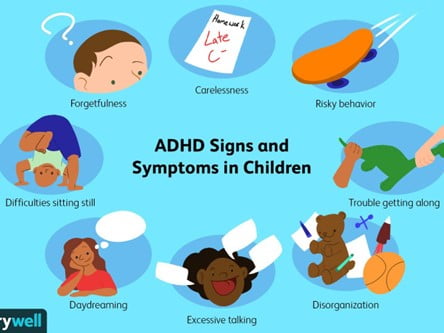
Source: Indian Express
Syllabus
- Prelims – Science & Technology
In News: Meat and seafood retailer Licious forayed into the marketing of “mock” chicken and mutton under a new ‘UnCrave’ brand.
- Many celebrities such as cricketer M S Dhoni and Indian cricket captain Virat Kohli have also invested in plant-based meat businesses.
- Actor couple Riteish and Genelia Deshmukh had founded plant-based Imagine Meats in September 2021.
- Retail sales of plant-based animal product alternatives in the US stood at $7.4 billion in 2021.
What is plant-based meat & dairy:
- “Plant-based” refers to products that bio-mimic or replicate meat, seafood, eggs, and milk derived from animals — by looking, smelling, and tasting like them.
- The variety includes mutton samosas, chicken nuggets, momos, fries, etc.
- Beyond Meat’s patties, apart from using coconut oil to copy the melty beef fat of a real hamburger, apparently even bleed as they cook — the “blood” coming from a beetroot juice-based liquid.
- Plant-based dairy products include ice-cream that isn’t simply frozen dessert that replaces milk fat with vegetable oil. Even the proteins and other solids-not-fat ingredients are sourced from plants.
Methodology:
- Animal meat contains protein, fat, vitamins, minerals, and water, just like plants.
- This biochemical similarity allows for finding analogues in the plant kingdom or making them through mechanical, chemical, or biological treatment of such ingredients.
- The challenge lies in replicating muscle tissue that plants don’t have.
- The unique spatial arrangement of proteins in these tissues is what creates the distinct texture of animal meat.
- That’s why plant-based mutton samosas, kebabs or keema, having a simpler texture, are easier to make than larger whole cuts of animal meat such as chicken breasts and pork chops.
- As for plant-based dairy, the main products are milk from oats, almond, soyabean, coconut, and rice. Among these, oat milk is considered the closest to regular milk in taste and texture. It is also thicker and creamier, as oats absorb more water than nuts or rice during soaking, and more of the grain gets strained for incorporation into the final product.
Scope in India – meat & milk:
- Due to India’s significant vegetarian population, plant-based meat does not see much potential in India.
- Plant-based meat can have only a niche market relevant for the top 1%.”
- Most Indians take naturally to milk, which is a classic “superior food”.
- Both milk (which includes ghee, curd, butter, ice-cream and other dairy products) and, to a lesser extent, meat (which includes fish and prawn) are superior foods — unlike cereals and sugar, whose share in the value of consumption reduces with increasing incomes, making them “inferior foods”.
- Digestive concerns like lactose intolerance aren’t very serious in India and, at any rate, pale in comparison to the perception of milk as a wholesome food.
- “Plant-based beverages cannot compete with real milk either on nutrition, taste, or affordability.
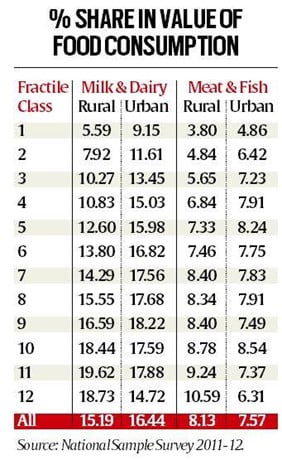
Source: Indian Express
Syllabus
- Prelims – Environment
In News: the Indian government is considering a proposal from Colombo to export 6 gaurs, or Indian bisons, to Sri Lanka to revive the population of gavaras that have been extinct in the island since the end of the 17th century.
- It would be the first such agreement between India and Sri Lanka, and part of a global trend of “wildlife or zoological diplomacy”.
About:
- The proposal is to transport at least six specimens, including a bull and three to five cows.
- The Sri Lankan Department of Zoological Gardens would carry out “captive breeding a herd of about a dozen specimens over a five-year period before trial reintroduction to the wild could take place in accordance with [internationally mandated] guidelines for reintroductions.
- The suggestion for the proposal came from world-renowned Sri Lankan conservationist Rohan Pethiyagoda, who was awarded the Linnean medal 2022 (U.K. -based equivalent of the Nobel prize for zoology) for his work on restoring fresh water and forest biodiversity.
Considerations:
- “Zoological diplomacy” has been practised worldwide, but there is a distinction between “gifts or loans” of animals in captivity to translocation and reintroduction of a species, particularly between neighbouring countries with similar eco-systems.
- Much depends on whether the conditions that caused the extinction have been removed, but reintroduction is known and has frequently been taken up between countries where the range is contiguous.
- In that sense, the animal plays a role as a zoological ambassador between nation states.
About Indian Gaur:
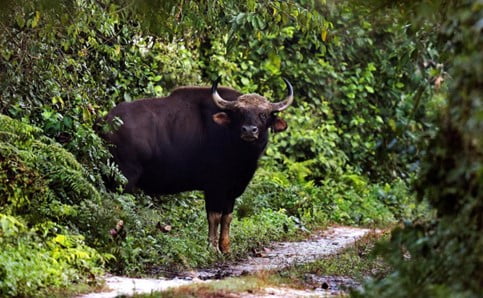
- The Indian gaur, a reclusive beast that lives in the wild, is the largest wild bovine that is a protected species and included in Schedule I of the Wild Life Protection Act, 1972
- IUCN Red List status: Vulnerable
- There are about 13,000 to 30,000 gaurs in the world with approximately 85% of the population present in India.
- It is also found in Burma and Thailand.
- The domesticated form of the gaur is called gayal (Bos frontalis) or mithun
- The first-ever population estimation exercise of the Indian gaur carried out in the Nilgiris Forest Division in February 2020 estimated around 2,000 Indian gaurs to be inhabiting the division.
- This came after instances of people being attacked or injured by the bison primarily in and around plantations came to light.
- Sri Lankan gaur, called the gavara in Sinhala, was once widespread and archaeological remains in ancient caves in the island included the remains of the animal.
Source: The Hindu
Previous Year Questions:
Q.1) Recently there was a proposal to translocate some of the lions from their natural habitat in Gujarat to which one of the following sites?(2017)
- Corbett National Park
- Kuno Palpur Wildlife Sanctuary
- Mudumalai Wildlife Sanctuary
- Sariska National Park
Syllabus
- Prelims – Geography
- Mains – GS 1 (Geography)
Context: According to a recent study, cold ocean currents have sheltered the Galápagos Islands from global warming.
- Ocean currents are the continuous, predictable, directional movement of seawater driven by gravity, wind (Coriolis Effect), and water density. Ocean water moves in two directions: horizontally and vertically.
- Horizontal movements are referred to as currents, while vertical changes are called upwellings or down welling.
- This abiotic system is responsible for the transfer of heat, variations in biodiversity, and Earth’s climate system.
Overcoming Global Warming:
- The islands are protected from an otherwise warming Pacific Ocean by a cold, eastward equatorial ocean current and this current has been gaining strength for decades.
- The temperatures in waters along the west coast of the Galápagos have dropped by 0.5 degrees Celsius since the early 1990s.
- There’s a tug of war between global warming and the cold ocean current. Right now, the ocean current is winning — it’s getting cooler year after year.
Importance of Phenomenon:
- This phenomenon is a cause for cautious optimism for the Galápagos Islands.
- Flora and fauna of the Galápagos could assist reseed failing ecosystems and maintain the region’s fisheries.
- Corals do not bleach and die in these waters off the west coast of Ecuador. So, the marine food chain does not suffer, unlike in the warm waters nearby.
- As the Galápagos so far has been relatively unaffected by climate change, it’s worth looking at the Galápagos as a potential site to really try to put some climate change mitigation efforts into.
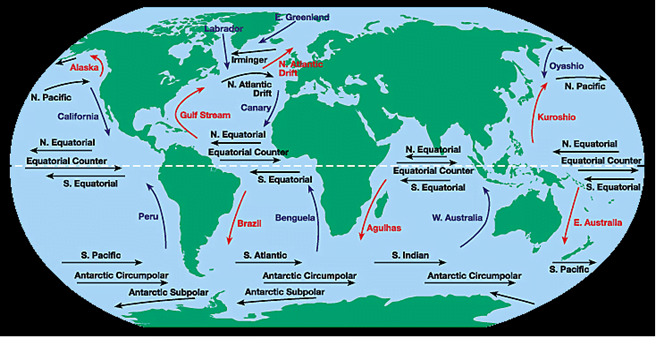
Significance of Ocean Current:
- Nutrient-rich Water: The equatorial undercurrent in the Pacific Ocean is bound to the equator by the force of the planet’s rotation.
- Under the ocean’s surface, a swift circulation of cold, nutrient-rich water flows from west to east.
- Some of this water is forced to the surface when it reaches the Galápagos Islands.
- The nutrient-rich water triggers photosynthesis and leads to an explosion of food for a wide variety of animals.
- Stability for Coral Reefs: The cold ocean current creates a cooler, more stable environment for coral reefs and marine life and birds that often live much closer to the poles.
- Position from Equator: From space, the Galápagos may appear to be a collection of minuscule specks in the eastern Pacific Ocean. However, it is their precise position on the equator that makes them significant.
Impact of Climate Change on Ocean Currents:
- Influx of Warm Freshwater: Climate change leading to increases in ocean temperatures, evaporation of seawater, and glacial and sea ice melting could create an influx of warm freshwater onto the ocean surface.
- Blocking Ice Formation: This would further block the formation of sea ice and disrupt the sinking of denser cold, salty water.
- Excess Heat in Atmosphere: The shallow, speedy currents could ultimately limit how much heat the ocean can absorb, causing more of that excess heat to remain in the atmosphere.
- Altering Global Temperatures: These events could slow or even stop the ocean conveyor belt, which would result in global climate changes that could include drastic decreases in Europe’s temperatures due to a disruption of the Gulf Stream.
- Affecting Marine Biodiversity: Marine microbes and wildlife could be subjected to shallower, hotter, and faster surface waters.
Challenges arising out of Ocean Currents:
- Future of Current: The worry is if in the future there are changes in this current, it could be really devastating for the ecosystem.
- Regulation of Overfishing: The island group is certainly in need of greater protection from overfishing as well as the pressures of growing eco-tourism.
- Human Pressures: The human pressures on this area and the mechanism that keeps it alive are at odds. It’s a major resource that should be protected.
- Adverse Impact of El Niño: El Niño poses a threat to the island group. It shuts down the cold current every couple of years, causing penguin populations to collapse. El Niño is a climate pattern that causes unusual warming of surface waters in the eastern tropical Pacific Ocean.
Way Forward:
- Ocean currents can regulate global climate, helping to counteract the uneven distribution of solar radiation reaching Earth’s surface.
- Without currents in the ocean, regional temperatures would be more extreme — super hot at the equator and frigid toward the poles — and much less of Earth’s land would be habitable.
About Galápagos Islands:
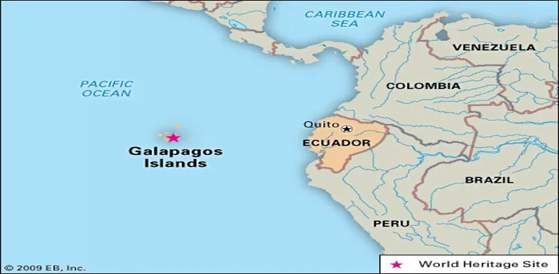
- An archipelago of volcanic islands.
- They are distributed on each side of the equator in the Pacific Ocean.
- The second-largest marine reserve in the world and contributed to the inception of Darwin’s theory of evolution.
- They designated as a UNESCO World Heritage Site and described as a “living museum and showcase of evolution.”
- The island is a biodiverse ecosystem — home to several endangered species.
- Galápagos is home to the critically endangered — Galápagos penguin, Galápagos fur seal and Galápagos sea lion.
Source: Down To Earth
Previous Year Questions
Q.1) With reference to the water on the planet Earth, consider the following statements:
- The amount of water in the rivers and lakes is more than the amount of groundwater.
- The amount of water I n polar ice caps and glaciers is more than the amount of groundwater.
Which of the statements given above is/are correct? (2021)
- 1 only
- 2 only
- Both 1 and 2
- Neither 1 nor 2
Syllabus
- Prelims – Environment
- Mains – GS 3 (Environment and Ecology)
Context: Recently, the Supreme Court (SC) directed that every protected forest, national park and wildlife sanctuary across the country should have a mandatory eco-sensitive zone (ESZ) of a minimum one km starting from their demarcated boundaries.
Eco Sensitive Zone (ESZ):
- The Eco-Sensitive Zone (ESZ) are areas in India notified by the Ministry of Environment, Forest and Climate Change (MoEF&CC), Government of India around Protected Areas, National Park and Wildlife sanctuaries.
- To create some kind of “shock absorbers” to the protected areas by regulating and managing the activities around such areas.
- Therefore, these areas act as a buffer for protected areas and reduce developmental pressures around a wildlife sanctuary or national park.
- They also act as a transition zone from areas of high protection to areas involving lesser protection.
Range:
- All identified areas around Protected Areas and wildlife corridors to be declared as ecologically fragile under the Environment (Protection) Act, 1986 (National Wildlife Action Plan, 2002-2016).
- Eco-sensitive Zone could go upto 10 Kms around Protected Areas.
- In cases where sensitive corridors, connectivity and ecologically important patches, crucial for landscape linkage, are even beyond 10 Kms width.
- Further, Eco-sensitive zones may not be uniform all around and it could be variable width and extent.
Prohibited activities:
- Activities like industries which cause pollution Commercial mining, saw mills, establishment of major hydroelectric projects (HEP), commercial use of wood, Tourism, discharge of effluents or any solid waste or production of hazardous substances are all prohibited.
Regulated activities:
- Activities like felling of trees, establishment of hotels and resorts, commercial use of natural water, erection of electrical cables, drastic change of agriculture system, e.g., adoption of heavy technology, pesticides etc., widening of roads.
Permitted activities:
- Activities like ongoing agricultural or horticultural practices, rainwater harvesting, organic farming, use of renewable energy sources, adoption of green technology for all activities are permitted.
Significance of Eco Sensitive Zone (ESZ):
- ESZs help in in-situ conservation, which deals with conservation of an endangered species in its natural habitat. For example, the conservation of the One-horned Rhino of Kaziranga National Park, Assam.
- They minimize forest depletion and man-animal conflict.
- The protected areas are based on the core and buffer model of management, through which local area communities are also protected and benefitted.
Significance of Recent Judgement:
- It can lead to more sustainable development.
- Tribal rights will also be protected with the recent judgement i.e., their culture, diversity etc will be preserved.
Challenges Ahead:
Developmental activities:
- Activities such as construction of dams, roads, urban and rural infrastructures in the ESZ, create interference, negatively impact upon the environment and imbalance the ecological system.
Blatant violations:
- To cater to the increasing demand for eco-tourism, land around parks and sanctuaries is being cleared through deforestation, displacement of local people etc.
- Failing to recognize the rights of forest communities and curbing poaching of animals, environmental legislations undermine the ESZs in favour of developmental activities.
Climate Change:
- Biodiversity and climate change are interconnected, for example, the rise in global temperature has generated land, water and ecological stress on the ESZs.
Tourism related Pollution:
- As the pressure of tourism is rising, the government is developing new sites and gateways to the ESZ. The tourists leave behind garbage such as plastic bags and bottles etc. which lead to environmental degradation.
Local communities:
- Slash and burn techniques used in agriculture, pressure of increasing population and the rising demand for firewood and forest produce, etc. exerts pressure on the protected areas.
Way Forward:
- The Centre needs to come up with a plan to incentivise farmers for sticking to green practices in Eco Sensitive Zones (ESZs).
- Communities living around Protected Areas in several states should promote conservation of Eco Sensitive Zones (ESZs).
- There is a need for rethinking on the impacts of the environmental policies at the local level and prospects of local participation.
Source: The Hindu
Syllabus
- Prelims – Economy
- Mains – GS 3 (Economy)
Context: The 2022 Nobel in economics was jointly awarded to Diamond, Dybvig and former U.S. Federal Reserve chairperson Ben S. Bernanke for their “research on banks and financial crises” undertaken in the early 1980s which have formed the foundations of what constitutes most modern banking research. They offered a deeper understanding of the genesis, the propagation, and the management of financial crises.
Financial crises:
- The financial sector plays a major role in modern economies and banks are the cornerstone of the financial system.
- They mobilise savings for investments, create opportunities to pool risks, improve allocative efficiencies, and lower transaction costs when funds exchange hands between borrowers and lenders.
- Interestingly, the very mechanisms that enable banks to offer these valuable services are also those which, at times, make banks vulnerable to small shocks and market sentiments, triggering a financial crisis and/or bank run with severe consequences.
- According to Diamond and Dybvig, even in this ideal environment banks may fail to meet obligations to depositors due to a different kind of risk — the risk associated with maturity transformation which banks have to undertake to be viable.
Asset- liability mismatch :
- Consider a bank that takes deposits from many small savers, like you and me.
- We may face a sudden need for cash due to unforeseen circumstances. Therefore, we prefer to put our savings in liquid deposit accounts from which we can withdraw at minimum notice.
- On the other hand, the firms that borrow from the bank prefer loans with longer maturity since they want to invest the money in business activities.
- To make its operation viable, a bank has to pay attention to the needs of both sets of customers. Thus, a bank has to turn short-term deposits into long-term lending.
- Under ordinary circumstances, a bank’s day-to-day operation remains unaffected by this mismatch of its assets (loans) and liabilities (deposits) because withdrawals by depositors largely uncorrelated.
- On a given day, only a fraction of depositors faces an unforeseen need for cash and the need to withdraw money from their accounts.
A framework used as an explainer:
- Repeated observations of borrower behaviour allows banks to set aside a fraction of deposits needed to meet the daily demand for withdrawal and safely give out the rest as loans with longer maturities.
- This process works well as long as each depositor expects other depositors to withdraw only when they have real expenditure needs.
- But suppose something changes for the depositors (economic or political events for example). This could trigger a belief among the depositors that their deposits are at risk.
- The depositors know that a bank has locked a significant fraction of its deposits in loans that cannot be quickly called in, and also anticipate that other depositors will want to withdraw their funds.
- Consequently, the best strategy for a depositor under these circumstances would be to withdraw his/her own money before it runs out.
- This bank run can potentially trigger a financial crisis.
- Incidentally, a way to prevent such crises and runs is to offer deposit insurance, which many governments have implemented.
- For example, India has the Deposit Insurance and Credit Guarantee Corporation (DICGC) Act under which currently Banks, including regional rural banks, local area banks, foreign banks with branches in India, and cooperative banks, are mandated to take deposit insurance cover with the Deposit Insurance and Credit Guarantee Corporation (DICGC).
- DICGC now provides insurance cover of maximum Rs 5 lakhs per depositor.
- The Diamond-Dybvig framework has been used to explain how financial development affects the rest of the economy and to understand the effects of monetary policy on banks’ portfolio choices.
Credit market’s role:
- The other winner Ben Bernanke, made significant contributions to our understanding of the credit market’s role in propagating and accentuating the effects of shocks.
- During the great depression of the 1930s, nearly 7,000 banks in the United States failed taking with them $7 billion in depositors’ assets. One can view bank failures at this scale as a consequence of a deep economic downturn and stop there.
- However, Bernanke in a 1983 paper argued that the disruptions of 1930-33 reduced the effectiveness of the financial sector as a whole by increasing the real costs of intermediating in the market and making credit more expensive and difficult to obtain.
- Consequently, bank runs played an important role in converting the severe but not unprecedented downturn of 1929-30 into a protracted depression.
- Bernanke’s research on the banking sector upholds the belief that favourable credit market conditions are essential for moderating shocks.
Way Forward:
- Overall, the three Economics Nobel winners of 2022 cover different but complementary aspects of financial intermediation and banking, from which Indian government and regulators can learn a lesson or two.
About DICGC:
- It was established in 1978 after the merger of Deposit Insurance Corporation (DIC) and Credit Guarantee Corporation of India Ltd. (CGCI) after passing of the Deposit Insurance and Credit Guarantee Corporation Act, 1961 by the Parliament.
- It is a wholly-owned arm of the Reserve Bank of India (RBI), which offers deposit insurance.
- It insures deposit accounts, such as savings, current, recurring, and fixed deposits up to a limit of Rs 5 lakh per account holder of a bank.
- If a customer’s deposit amount crosses Rs 5 lakh in a single bank, only up to Rs 5 lakh, including the principal and interest, will be paid by the DICGC if the bank turns bankrupt.
- Coverage: Deposits in public and private sector banks, local area banks, small finance banks, regional rural banks, cooperative banks, Indian branches of foreign banks and payments banks are all insured by the DICGC.
- Funds: The Corporation maintains the following funds :
- Deposit Insurance Fund
- Credit Guarantee Fund
- General Fund
- The first two are funded respectively by the insurance premia and guarantee fees received and are utilised for settlement of the respective claims.
- The General Fund is utilised for meeting the establishment and administrative expenses of the Corporation.
Source: The Hindu
Syllabus
- Mains – GS 1 Indian Society, GS 2 Governance
In News: Launching a nationwide campaign against child marriage from Rajasthan, Nobel Peace Laureate Kailash Satyarthi has appealed to the nation to initiate collective action against child marriage to end the social evil.
Context:
- The Kailash Satyarthi Children’s Foundation (KSCF) will spearhead the campaign.
- As part of the campaign, 70,000 women and girls led people in lighting lamps, torchlight processions in around 10,000 villages (6,015 villages by KSCF and rest by government and other agencies) from over 500 districts in 26 states.
- The campaign was launched with another Nobel Peace Laureate, Leymah Gbowee.
- The ‘Child Marriage Free India’ campaign has three major objectives — to ensure the strict implementation of law; to enhance participation of children and women and ensure their empowerment through giving them free education till the age of 18; and to provide safety to children against sexual exploitation.
- Government agencies, including Railway Protection Force, Women and Child Development Department of 14 states, state child protection authorities, state legal services authorities, Anganwadis and district administration of several state governments joined the campaign.
Child marriage in India:
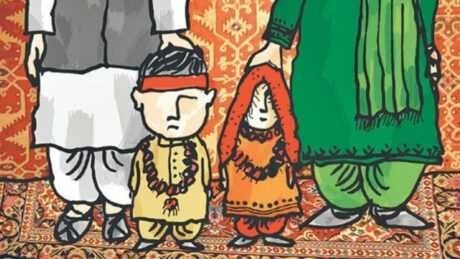
- Child marriage usually refers to a social phenomenon where a young child (usually a girl below the age of fifteen) is married to an adult man.
- The second form of practice of child marriage is that in which the parents of the two children (the girl and boy) arrange a future marriage.
- In this practice, the individuals (the boy and girl) do not meet one another until they reach the marriageable age, when the wedding ceremony is performed.
- Child marriage prevalence is generally defined as the percentage of women 20-24 years old who were married or in union before age 18.
- As per law, the marriageable age is 21 for males and 18 for females.
- Girl children in rural areas are more affected than their urban counterparts.
- India is estimated to have over 24 million child brides; 40% of the world’s 60 million child marriages take place in India according to the National Family Health Survey.
- India has the 14th highest rate of child marriage in the world, according to the International Center for Research on Women.
- Marriage systems and practices vary by region, caste and tribe.
- Rates of child marriage are higher in the North-West and lower in the South-East of the country.
- The states with the highest rates of child marriage (50% and above) are Bihar, Rajasthan, Jharkhand, Uttar Pradesh, West Bengal, Madhya Pradesh, Andhra Pradesh and Karnataka.
- Rajasthan had emerged as the State with the highest incidence of child marriage both among boys, which was 8.6%, and girls, which was 8.3%, in the 2011 Census.
- According to the National Family Health Survey-4 data collected in 2015-16, 16.2% of the girls aged 15 to 19 years were married before the age of 18 in Rajasthan, with variations across districts.
- In Bihar, nearly 70% of women in their early twenties reported having been married by the age of 18.
- According to DLHS data, around 48% of married women in the 20-24 year age group got married before 18 in rural areas, compared with 29% in urban areas.
- Over the past fifteen years, child marriage has declined by just 11 percent – less than one percent per year.
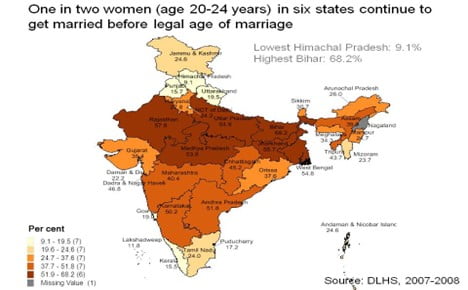
Causes of child marriage:
- Gender inequality such as declining sex-ratio, sex-selective abortions
- Economic considerations such as leeway to large dowry
- Social norms
- Perceived low status of girls
- Poverty
- Lack of education
- Safety concerns about girl children
- Control over sexuality and chastity of a young bride
- Honour killings
Challenges:
- Child marriage is a violation of human rights and dignity.
- It negatively influences children’s rights to education, health and protection. These consequences impact not just the girl directly, but also her family and community.
- This social evil propels an unending list of crimes against children, especially against our daughters. A child bride is more likely to experience domestic violence and become infected with HIV/AIDS.
- Child marriage negatively affects the Indian economy and can lead to an intergenerational cycle of poverty. Girls and boys married as children more likely lack the skills, knowledge and job prospects needed to lift their families out of poverty and contribute to their country’s social and economic growth.
- Lack of feminist lawmaking and policy-making, and two, the lack of implementation of extant legal provisions and policies.
- Rural poverty implies lack of economic benefits emanating from educating their girls since they will leave their house after marriage.
- Low levels of literacy implies people do not indulge in family planning for there is a notion that more children are more hands to work.
- Cultural practices perceive unmarried women as liabilities for family integrity and honour.
Legislative Framework:
- The Child Marriage Restraint Act, 1929 or Sarda Act fixed the age of marriage for girls at 14 years and boys at 18 years.
- Pre-Conception and Pre-Natal Diagnostic Techniques Act (1994) to prohibit prenatal diagnostic techniques for determination of the sex of the foetus leading to female feticide.
- The Prohibition of Child Marriage Act, 2006
- Legal age for marriage in India is eighteen for girls and twenty-one for boy
- Full-time “Child Marriage Prohibition Officers” are appointed in every state and are supposed to police instances of child marriage.
- These officers are vested with the authority to prevent child marriages, make documented reports of violations, charge offenders that can also include the child’s parents and even remove children from dangerous and potentially dangerous situations.
- The option of the child that has been married off – allowing her to declare her marriage void at any time up to two years after reaching adulthood.
- The only exception where a child marriage can be declared as void even before the child reaches the age of 18, is when the child has been abducted, kidnapped, trafficked or been compelled to marry under force, deceit, coercion or misrepresentation.
- The legislation also penalizes the arrangement, performance or participation in child marriages.
- Child marriage is punishable by imprisonment of up to two years, or may be charged with a fine of up to one lakh rupees, or both.
- By Section 10, these penalties are extended to anyone who performs, conducts, directs or abets a child marriage unless he can prove that he had reason to believe that the marriage was no child marriage.
- If the child herself contracts for a child marriage, under Section 11, any parent or guardian who actively supports the marriage or negligently fails to prevent it is punishable by way of imprisonment and or a fine.
Measures:
- In 2009, the MWCD introduces a pilot scheme called Dhanalakshmi, as a conditional cash transfer scheme providing cash to the family of the girl child.
- Beti Bachao Beti Padhao aims to curb sex-selective abortion or female foeticide.
- As per a UNICEF report, two of every three child marriages would be stopped in the world only if all girls could complete secondary school.
- Better quality of education and higher literacy rates among women is directly linked to lower cases of child marriage, as per the non-profit Child Rights and You (CRY) showed.
- National Population Policy 200043 and the National Youth Policy 2003,44 there were strategies to address the vulnerability of girls in the context of child marriages.
- The provision of non-formal education and vocational training, development of livelihood skills and education and awareness of sexual and reproductive health issues.
Way forward
- At the global level, child marriage is included in Goal 5 “Achieve gender equality and empower all women and girls”.
- The Ministry of Women and Child Development supports a child help line service (Toll free number 1098) to reach out to children in distress.
Source: Indian Express
Baba’s Explainer – U.K.’s Economic Crisis
Syllabus
- GS-II- International Event
- GS-III- Economy
Context: Recently, British Prime Minister Liz Truss fired Chancellor of the Exchequer (chief finance minister of UK) and dropped parts of their economic package that had been previously announced to tackle increasing inflation and sooth market turbulence.
Read Complete Details on U.K.’s Economic Crisis
Daily Practice MCQs
Q.1) The terms ‘ WASP-76b and WASP-121b’ sometimes mentioned in the news recently are related to
- Exoplanets
- Black Holes
- Mini satellites
- Magnetars
Q.2) With reference to Indian Bison, consider the following statements:
- It is endemic only to India.
- More than 80% of its population is present in India.
- It is categorised as ‘Endangered’ species in IUCN’s Red List.
Which of the statements given above is/are correct?
- 1 and 2 only
- 2 only
- 3 only
- 2 and 3 only
Q.3) Consider the following statements regarding Deposit Insurance and Credit Guarantee Corporation (DICGC):
- It is a wholly-owned arm of the Reserve Bank of India (RBI), which offers deposit insurance.
- It insures deposit accounts, such as savings, current, recurring, and fixed deposits up to a limit of Rs 10 lakh per account holder of a bank.
- The Corporation maintains Deposit Insurance Fund, Credit Guarantee Fund and General Fund.
Which of the above statements is/are correct?
- 1 and 2 only
- 2 and 3 only
- 1 and 3 only
- 1 2 and 3
Comment the answers to the above questions in the comment section below!!
ANSWERS FOR ’18th October 2022 – Daily Practice MCQs’ will be updated along with tomorrow’s Daily Current Affairs.
ANSWERS FOR 17th October – Daily Practice MCQs
Q.1) – b
Q.2) – a
Q.3) – d












